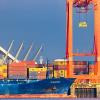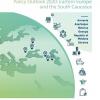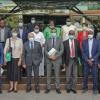News
Displaying Results 126 - 146 of 146
In 2021, the volume of world merchandise trade is expected to increase by 8 per cent after falling 5.3 per cent in 2020. How UN/CEFACT recommendations and e-business standards can help boost trade and e-commerce was one of the key topics of the 36th UN/CEFACT Forum, convened online, by UNECE over…
Between 1999 and 2018, nearly 6,000 different species of illegally-traded fauna and flora were seized worldwide. The Convention on International Trade in Endangered Species of Wild Fauna and Flora (CITES) aims at ensuring sustainable livelihoods and protecting ecosystem. CITES provides protection…
Water, health, climate change and disaster risk reduction are interlinked and interdependent. For example, with climate change, floods and droughts increase in both intensity and frequency. Floods can damage water and sanitation infrastructure, disrupt essential public service provision, undermine…
A small sub-set of small- and medium-sized enterprises – innovative, high-growth enterprises (IHGEs) – play an outsize role in innovation and structural transformation across the world. They spearhead experimentation with new ideas to create value, address challenges, and reduce transaction costs…
The countries of Eastern Europe and the South Caucasus (the EESC sub-region), Armenia, Azerbaijan, Belarus, Georgia, the Republic of Moldova and Ukraine have come a long way in their transition from centrally planned towards market-based economies. After a difficult first decade following…
While consumer demand for sustainable goods is an important driver for change, regulation and policy change are essential if the world is to side-step a climate catastrophe and bend traditional linear economic models towards a circular economy and sustainable future. Until recently it wasn’t clear…
Uzbekistan has shown remarkable growth in its transition from a centrally planned to a market based economy, with annual growth rates between 5 and 9 per cent since 2004. Innovation, namely fostering experimentation and collaboration between innovation stakeholders to find new ways for creating…
The days of voluntary measures to improve sustainability in the garment and footwear sector appear to be numbered, according to speakers at a recent event. With regulation and smart policy implementation, the sector has the potential to build back better post-COVID-19, prioritising the environment …
Water scarcity and pollution is increasing worldwide, as a result of the rising economic demands for water, population growth and rapid urbanisation, exacerbated by ecosystem losses and climate change. Water-related risks can negatively affect sustainable development, human health and well-being, …
Waste has turned into one of humanity’s predominant challenges. The generation of hazardous waste increased from an estimated 259 metric tonnes in 2007 to 394 metric tonnes in 2015; the most significant increases were from lower middle-income and higher middle-income countries and despite policy…
Directive (EU) 2020/2184 of the European Parliament and of the Council of 16 December 2020 on the quality of water intended for human consumption (recast) was adopted by the European Parliament and the Council of the European Union on 16 December 2020 and entered into force on 12 January 2021. The…
While transboundary rivers, lakes and aquifers, accounting for 60 per cent of global freshwater flows, are of crucial importance for the sustainable development and political stability of riparian States, the financial means for their management, development and protection are insufficient in most…
Consumers are increasingly interested in making more environmentally and ethically aware choices when it comes to the clothes and shoes they wear, according to a series of recent studies. But the sector is awash with complex language and misleading labelling that makes it difficult for consumers to…
A vision for transboundary cooperation around the Senegal-Mauritanian Aquifer Basin (SMAB) has been developed by representatives of the States that share this aquifer system, namely The Gambia, Guinea Bissau, Mauritania and Senegal.
This work was carried out in the second meeting of the…
The current patterns of raw material consumption are unstainable and are becoming an existential threat to the planet.
The United Nations Framework Classification for Resources (UNFC) offers a solution to support a total transformation towards a sustainable resource management future. To…
The risk that advances in digital technology benefit those who are already online and could contribute to greater inequality within and among countries needs to be addressed by effective policies, leaving no one behind.
The United Nations system is engaged to help address these…
Innovation is central to build back better after the COVID-19 pandemic and to drive sustainable development. Making up over 10% of Gross Domestic Product globally, public procurement carries the potential to stimulate broad experimentation with new ideas and technologies to attain economic, social…
COVID-19 has significantly changed the way UN/CEFACT works. As the focal point within the United Nations Economic and Social Council for trade facilitation recommendations and electronic business standards, UN/CEFACT typically convenes experts twice per year to a week-long Forum to discuss current…
Digital platforms have the potential to transform society fundamentally – creating new opportunities for economic growth and unlocking benefits in terms of poverty reduction on the one hand, and environmental sustainability on the other. They could help support less resource-intensive consumption…
The countries of the UN Special Programme for the Economies of Central Asia (SPECA) - Afghanistan, Azerbaijan, Kazakhstan, Kyrgyzstan, Tajikistan, Turkmenistan and Uzbekistan - gathered for a virtual session of the SPECA Working Group on Innovation and Technology for Sustainable Development (WG on…
The world is urbanizing fast. Already today, half the population is living in cities. By 2050, that proportion is projected to rise to over two thirds. Cities are economic powerhouses, accounting for 80 percent of world GDP. They also have large ecological footprints, accounting for 60-80 percent…















